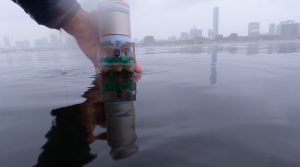MIT Team Develops Underwater GPS Powered By Sound
Written By: Kaylee Zhou
Oceans make up at least 70% of Earth, but only 5% of the seafloor has been mapped, which leaves no less than 65% of the oceans on Earth unexplored and unobserved (Emerson, 2016). Researchers have established that deepwater pressures, extremely cold temperatures, and little to no visibility have all contributed to the lack of ocean exploration (Petsko, 2020). However, a MIT research team has recently announced the invention of a new underwater GPS powered by sound, which raises hopes of new underwater explorations.
A GPS, which stands for Global Positioning System, is most commonly known as a system that shows the exact location of a person, place, or object by using satellite signals (Erickson, 2019). In this case, the MIT team seeks to use their newly invented GPS as a tool to help map ocean floors. They introduced their invention by the name of UBL, which stands for Underwater Backscatter Localization (Saad Afzal , 2020). Their UBL runs battery-free and is powered by an acoustic navigation system that takes advantage of the signals found in the surrounding environment rather than creating their own (Etherington, 2020).
Piezoelectric material significantly contributed to the UBL’s success because it has the ability to generate an electric charge when mechanical stress is applied. In this scenario, sound waves received by the piezoelectric material are then used to generate electrical power (Lang, 2020). Simultaneously, the material backscatters the sound waves into the environment, which is picked up by a receiver. The receiver then translates the picked up sound waves into either 1or 0, meaning it was either reflected or non-reflected, respectively. As for location technology, a sound wave has to be sent to the piezoelectric material, which will backscatter the soundwave back (Ryan Whitwam, 2020). By calculating the sound wave’s travel time, scientists can determine surrounding underwater conditions, such as ocean temperature, salt concentration, and location. So far, the UBL has been successful for distances up to 20 inches, or 50 centimeters, and the scientists are working on increasing this range (Goyal, 2020).

This photo shows the battery-free GPS before it is dipped into the Charles River, where it is being tested. Afzel, S.(2020). Battery-Free Underwater GPS. MIT Media Lab. https://www.media.mit.edu/projects/battery-free-underwater-gps/overview/
Although this UBL is successful, this group of MIT scientists did have previous setbacks between sound waves and the piezoelectric material used. Sound waves have a natural tendency to travel in all directions, which results in hectic acoustic environments that are computationally expensive (Ryan Whitwam, 2020). The team did account for this by using a method called “frequency hopping.” This is when the observational units release various frequencies of sound waves, which will then be backscattered in phases. The multiple phase arrival of sound waves helps control received signals. This “frequency hopping” method was successful in deeper waters, and the scientists are now experimenting with this method in shallower waters (Ryan Whitwam, 2020).
Ultimately, this invention has been a successful advancement in technology for underwater exploration, and future generations will be able to build upon development to create further improvements. Hopefully, one day this battery-free GPS will allow humans to understand the unknown conditions of all the ocean floors on Earth; but for now, these scientists have done a remarkable job in persistently working to improve their creation.
Sources and References
Emerson, S. (2016). Why Haven’t We Explored More of the Ocean? https://www.vice.com/en/article/pgk3z9/why-havent-we-explored-the-ocean-like-outer-space.
Erickson, K. (2019, June 27). How Does GPS Work? NASA. https://spaceplace.nasa.gov/gps/en/.
Etherington, D. (2020, November 2). MIT develops a battery-free method for navigating underwater that could transform ocean exploration. TechCrunch. https://techcrunch.com/2020/11/02/mit-develops-a-battery-free-method-for-navigating-underwater-that-could-transform-ocean-exploration/.
Goyal, N. (2020, November 5). Underwater GPS System Powered By Sound to Map Ocean Floors. Industry Tap. https://www.industrytap.com/underwater-gps-system-powered-by-sound-to-map-ocean-floors/55274.
Lang, F. (2020, November 3). MIT Team Develops Underwater GPS to Map Ocean Floors. IE. https://interestingengineering.com/mit-team-develops-underwater-gps-to-map-ocean-floors
Petsko, E. (2020). Why does so much of the ocean remain unexplored and unprotected? Oceana. https://oceana.org/blog/why-does-so-much-ocean-remain-unexplored-and-unprotected.
Ryan Whitwam , R. (2020, November 4). MIT Creates Battery-Free Underwater GPS. ExtremeTech. https://www.extremetech.com/extreme/316887-mit-creates-battery-free-underwater-gps.
Saad Afzal , S. (2020). Project Overview ‘ Battery-Free Underwater GPS. MIT Media Lab. https://www.media.mit.edu/projects/battery-free-underwater-gps/overview/.